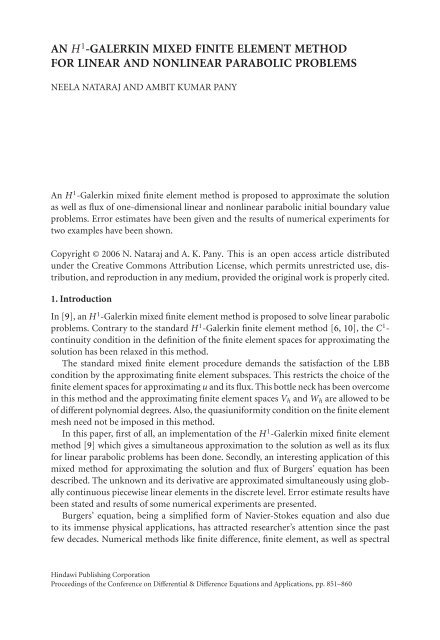DIFFERENtIAl & DIFFERENCE EqUAtIONS ANd APPlICAtIONS
DIFFERENtIAl & DIFFERENCE EqUAtIONS ANd APPlICAtIONS
DIFFERENtIAl & DIFFERENCE EqUAtIONS ANd APPlICAtIONS
You also want an ePaper? Increase the reach of your titles
YUMPU automatically turns print PDFs into web optimized ePapers that Google loves.
AN H 1 -GALERKIN MIXED FINITE ELEMENT METHOD<br />
FOR LINEAR AND NONLINEAR PARABOLIC PROBLEMS<br />
NEELA NATARAJ AND AMBIT KUMAR PANY<br />
An H 1 -Galerkin mixed finite element method is proposed to approximate the solution<br />
as well as flux of one-dimensional linear and nonlinear parabolic initial boundary value<br />
problems. Error estimates have been given and the results of numerical experiments for<br />
two examples have been shown.<br />
Copyright © 2006 N. Nataraj and A. K. Pany. This is an open access article distributed<br />
under the Creative Commons Attribution License, which permits unrestricted use, distribution,<br />
and reproduction in any medium, provided the original work is properly cited.<br />
1. Introduction<br />
In [9], an H 1 -Galerkin mixed finite element method is proposed to solve linear parabolic<br />
problems. Contrary to the standard H 1 -Galerkin finite element method [6, 10], the C 1 -<br />
continuity condition in the definition of the finite element spaces for approximating the<br />
solution has been relaxed in this method.<br />
The standard mixed finite element procedure demands the satisfaction of the LBB<br />
condition by the approximating finite element subspaces. This restricts the choice of the<br />
finite element spaces for approximating u and its flux. This bottle neck has been overcome<br />
in this method and the approximating finite element spaces V h and W h are allowed to be<br />
of different polynomial degrees. Also, the quasiuniformity condition on the finite element<br />
mesh need not be imposed in this method.<br />
In this paper, first of all, an implementation of the H 1 -Galerkin mixed finite element<br />
method [9] which gives a simultaneous approximation to the solution as well as its flux<br />
for linear parabolic problems has been done. Secondly, an interesting application of this<br />
mixed method for approximating the solution and flux of Burgers’ equation has been<br />
described. The unknown and its derivative are approximated simultaneously using globally<br />
continuous piecewise linear elements in the discrete level. Error estimate results have<br />
been stated and results of some numerical experiments are presented.<br />
Burgers’ equation, being a simplified form of Navier-Stokes equation and also due<br />
to its immense physical applications, has attracted researcher’s attention since the past<br />
few decades. Numerical methods like finite difference, finite element, as well as spectral<br />
Hindawi Publishing Corporation<br />
Proceedings of the Conference on Differential & Difference Equations and Applications, pp. 851–860

















